21/09 - 05/11, 2022
-
Ivana Bašić
-
Benni Bosetto
-
Ambra Castagnetti
-
Fin Simonetti
second best scenario
What if hundreds of miles below the ground there was an atomic pile, sunk for reasons unknown? second best scenario is based on an absurd assumption: a powerful generator that shifts the balance of the world is buried in the middle of the gallery, and Ivana Bašić, Benni Bosetto, Ambra Castagnetti and Fin Simonetti, immune to its radiation, need to look after it. Theirs is a very precise role: they are the vestal virgins tending to this radioactive divinity which needs nourishment, attention and caring gestures to give energy.
An artificial landscape fed by the protagonists of the show opens up before our eyes: a futuristic beauty salon, a group of hybrid organisms that emerge from the walls, barely visible faces on gothic windows and extra-terrestrial creatures with supernatural powers.
A world teetering on the brink of collapse, or a shelter for times to come, unfolds through the works of four distinct voices in response to an unlikely inspiration. The atomic pile, a metaphorical entity representing fantasy and the desire to give shape, needs daily and constant care and sustenance, and the works on display respond to this need.
We are welcomed into the atmosphere of an old wellness centre where objects take on human characteristics. Benni Bosetto’s mirrors (1987, IT) hung on the walls turn into esoteric tables, where amulets, bodies and nature intertwine. Hairdryer hoods come out of the wall like arms and tell of a timeless universe.
Ivana Basic’s works (1986, Belgrade) depict body wounds halfway between the alien and the human. The fusion of natural and artificial materials reminds us of primordial organs undergoing a process of mutation. What may seem recognizable is immediately engulfed by an amorphous and all-encompassing presence.
Lastly, Fin Simonetti (1985, Vancouver) turns space into a domestic and sacred place with works where the austerity of an almost clerical stained glass window enters into dialogue with faded barbershop posters. Torn from shop windows, the faces portrayed are now immutable, crystallized in an eternal time.
We find Ambra Castagnetti’s works (1993, IT) displayed as if around a fire in a cave. Fragmented bodies and grafts of different materials offer a fluid and intimate scenario where the fragile and the unbreakable come together in a vital and magical dance.
second best scenario is a world where reality and fiction, past present and future, merge to create infinite storylines.
Drawing on “Radiant Terminus”, the post-exotic novel by Antoine Volodine, we have invited four artists, linked by a common perception, to narrate a world that not only could become a refuge, but also spur us to imagine what lies beyond our eyes.
Giulia Gelmini
What if hundreds of miles below the ground there was an atomic pile, sunk for reasons unknown? second best scenario is based on an absurd assumption: a powerful generator that shifts the balance of the world is buried in the middle of the gallery, and Ivana Bašić, Benni Bosetto, Ambra Castagnetti and Fin Simonetti, immune to its radiation, need to look after it. Theirs is a very precise role: they are the vestal virgins tending to this radioactive divinity which needs nourishment, attention and caring gestures to give energy.
An artificial landscape fed by the protagonists of the show opens up before our eyes: a futuristic beauty salon, a group of hybrid organisms that emerge from the walls, barely visible faces on gothic windows and extra-terrestrial creatures with supernatural powers.
A world teetering on the brink of collapse, or a shelter for times to come, unfolds through the works of four distinct voices in response to an unlikely inspiration. The atomic pile, a metaphorical entity representing fantasy and the desire to give shape, needs daily and constant care and sustenance, and the works on display respond to this need.
We are welcomed into the atmosphere of an old wellness centre where objects take on human characteristics. Benni Bosetto’s mirrors (1987, IT) hung on the walls turn into esoteric tables, where amulets, bodies and nature intertwine. Hairdryer hoods come out of the wall like arms and tell of a timeless universe.
Ivana Basic’s works (1986, Belgrade) depict body wounds halfway between the alien and the human. The fusion of natural and artificial materials reminds us of primordial organs undergoing a process of mutation. What may seem recognizable is immediately engulfed by an amorphous and all-encompassing presence.
Lastly, Fin Simonetti (1985, Vancouver) turns space into a domestic and sacred place with works where the austerity of an almost clerical stained glass window enters into dialogue with faded barbershop posters. Torn from shop windows, the faces portrayed are now immutable, crystallized in an eternal time.
We find Ambra Castagnetti’s works (1993, IT) displayed as if around a fire in a cave. Fragmented bodies and grafts of different materials offer a fluid and intimate scenario where the fragile and the unbreakable come together in a vital and magical dance.
second best scenario is a world where reality and fiction, past present and future, merge to create infinite storylines.
Drawing on “Radiant Terminus”, the post-exotic novel by Antoine Volodine, we have invited four artists, linked by a common perception, to narrate a world that not only could become a refuge, but also spur us to imagine what lies beyond our eyes.
Giulia Gelmini
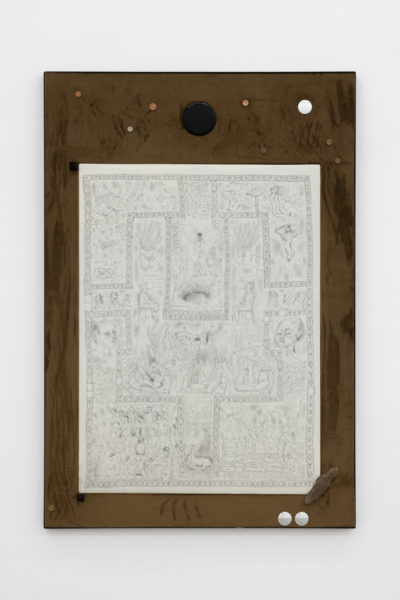 Benni Bosetto, Specchio (“L’uomo della buca”), 2022iron, wooden panel, foam, velvet, obsidian, black tourmaline, mirrors, coins, bark
Benni Bosetto, Specchio (“L’uomo della buca”), 2022iron, wooden panel, foam, velvet, obsidian, black tourmaline, mirrors, coins, bark
graphite on silk
160×110×4,5 cm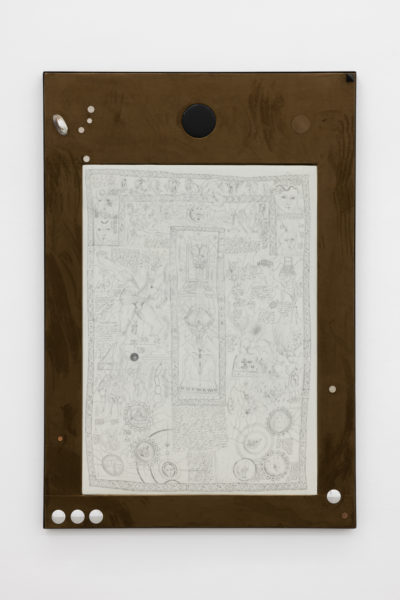 Benni Bosetto, Specchio (“If we want to resist submission, we must also mutate”), 2022iron, wooden panel, foam, velvet, obsidian, black tourmaline, mirrors, coins, seashell
Benni Bosetto, Specchio (“If we want to resist submission, we must also mutate”), 2022iron, wooden panel, foam, velvet, obsidian, black tourmaline, mirrors, coins, seashell
graphite on silk
160×110×4,5 cm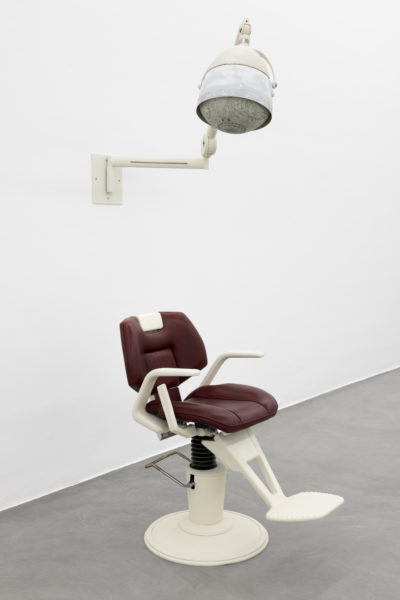 Benni Bosetto, Specchio (“Somewhere, always, somewhere, there’s a day when healing will come”), 2022, view 1hairdresser helmet, aluminium, iron, metal, spray paint, wooden panel, foam, graphite on silk
Benni Bosetto, Specchio (“Somewhere, always, somewhere, there’s a day when healing will come”), 2022, view 1hairdresser helmet, aluminium, iron, metal, spray paint, wooden panel, foam, graphite on silk
variable dimensions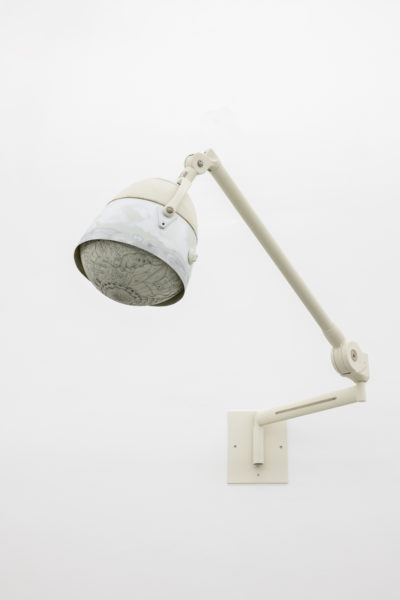 Benni Bosetto, Specchio (“Somewhere, always, somewhere, there’s a day when healing will come”), 2022, view 2hairdresser helmet, aluminium, iron, metal, spray paint, wooden panel, foam, graphite on silk
Benni Bosetto, Specchio (“Somewhere, always, somewhere, there’s a day when healing will come”), 2022, view 2hairdresser helmet, aluminium, iron, metal, spray paint, wooden panel, foam, graphite on silk
variable dimensions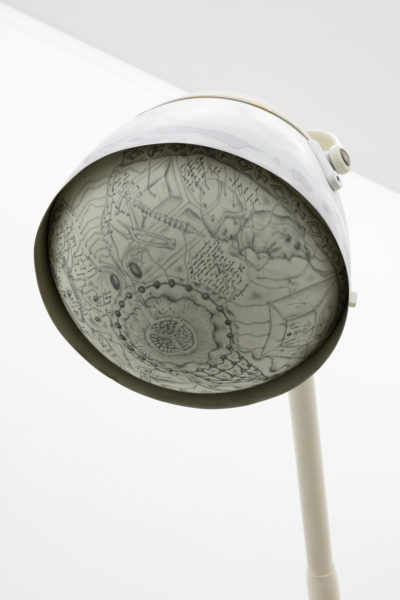 Benni Bosetto,hairdresser helmet, aluminium, iron, metal, spray paint, wooden panel, foam, graphite on silk
Benni Bosetto,hairdresser helmet, aluminium, iron, metal, spray paint, wooden panel, foam, graphite on silk
variable dimensions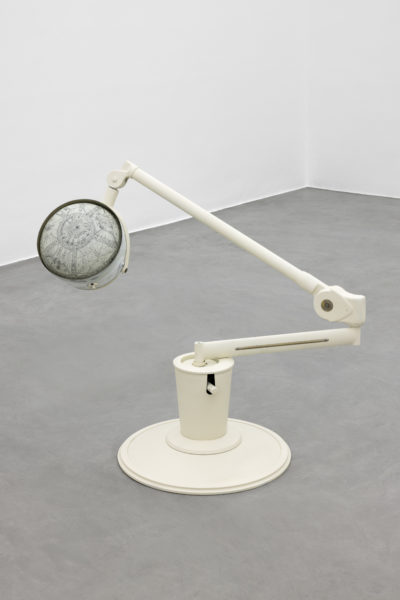 Benni Bosetto, Specchio (“Io guardo il cielo, il cielo che guardi tu”), 2022hairdresser helmet, aluminium, iron, metal, spray paint, wooden panel, foam, graphite on silk
Benni Bosetto, Specchio (“Io guardo il cielo, il cielo che guardi tu”), 2022hairdresser helmet, aluminium, iron, metal, spray paint, wooden panel, foam, graphite on silk
variable dimensions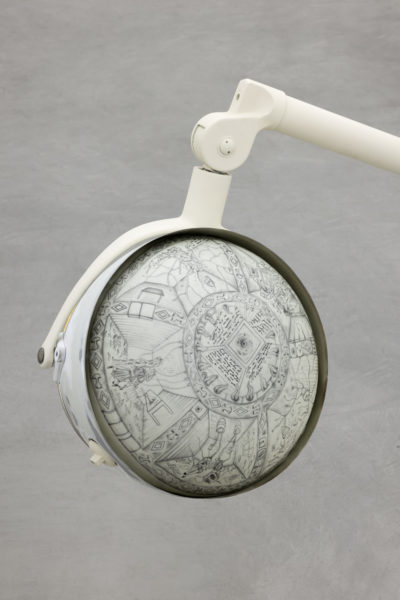 Benni Bosetto, Specchio (“Io guardo il cielo, il cielo che guardi tu”), 2022, detailhairdresser helmet, aluminium, iron, metal, spray paint, wooden panel, foam, graphite on silk
Benni Bosetto, Specchio (“Io guardo il cielo, il cielo che guardi tu”), 2022, detailhairdresser helmet, aluminium, iron, metal, spray paint, wooden panel, foam, graphite on silk
variable dimensions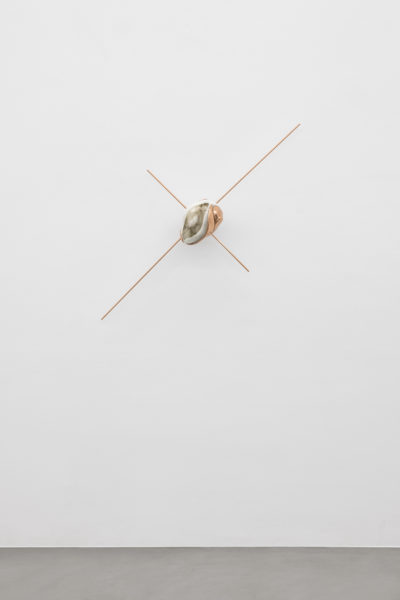 Ivana Bašić, I sense that all of this is ancient and wast. I had touched the nothing, and nothing was living and moist #3, 2022, view 1White alabaster, wax, copper, pressure, grounding rods, stainless steel
Ivana Bašić, I sense that all of this is ancient and wast. I had touched the nothing, and nothing was living and moist #3, 2022, view 1White alabaster, wax, copper, pressure, grounding rods, stainless steel
66×47×19,5 cm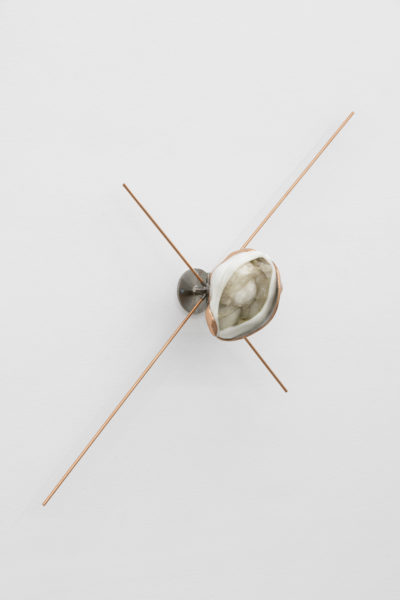 Ivana Bašić, I sense that all of this is ancient and wast. I had touched the nothing, and nothing was living and moist #3, 2022, view 2White alabaster, wax, copper, pressure, grounding rods, stainless steel
Ivana Bašić, I sense that all of this is ancient and wast. I had touched the nothing, and nothing was living and moist #3, 2022, view 2White alabaster, wax, copper, pressure, grounding rods, stainless steel
66×47×19,5 cm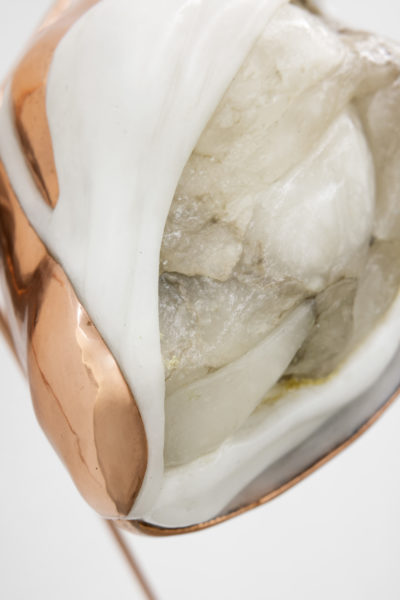 Ivana Bašić, I sense that all of this is ancient and wast. I had touched the nothing, and nothing was living and moist #3, 2022, detailWhite alabaster, wax, copper, pressure, grounding rods, stainless steel
Ivana Bašić, I sense that all of this is ancient and wast. I had touched the nothing, and nothing was living and moist #3, 2022, detailWhite alabaster, wax, copper, pressure, grounding rods, stainless steel
66×47×19,5 cm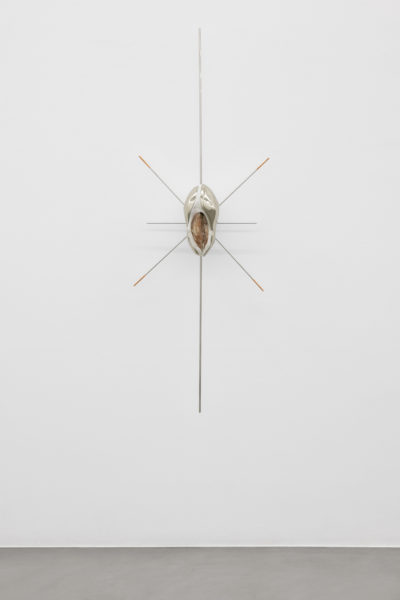 Ivana Bašić, I sense that all of this is ancient and wast. I had touched the nothing, and nothing was living and moist #1, 2022, view 1Steatite, wax, white bronze, pressure, copper, grounding rods, stainless steel
Ivana Bašić, I sense that all of this is ancient and wast. I had touched the nothing, and nothing was living and moist #1, 2022, view 1Steatite, wax, white bronze, pressure, copper, grounding rods, stainless steel
179,5×61×24,5 cm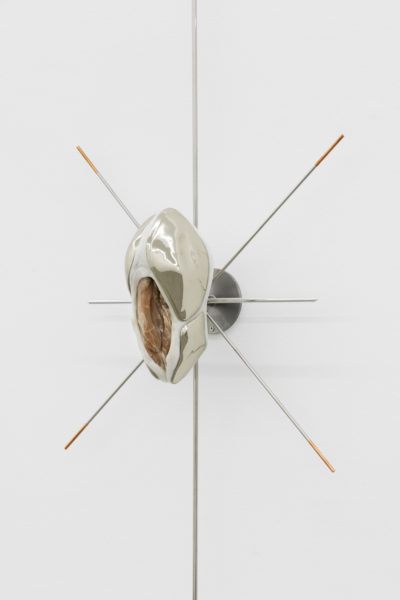 Ivana Bašić, I sense that all of this is ancient and wast. I had touched the nothing, and nothing was living and moist #1, 2022, view 2Steatite, wax, white bronze, pressure, copper, grounding rods, stainless steel
Ivana Bašić, I sense that all of this is ancient and wast. I had touched the nothing, and nothing was living and moist #1, 2022, view 2Steatite, wax, white bronze, pressure, copper, grounding rods, stainless steel
179,5×61×24,5 cm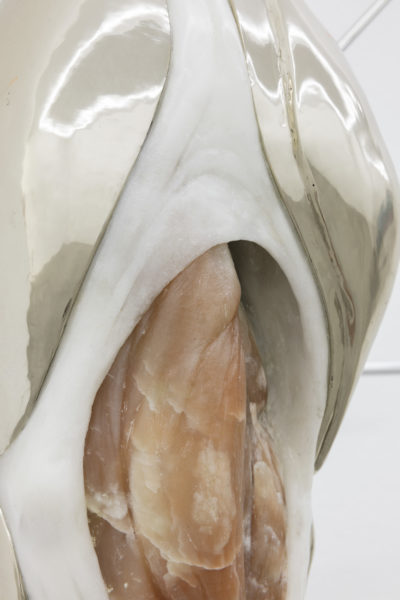 Ivana Bašić, I sense that all of this is ancient and wast. I had touched the nothing, and nothing was living and moist #1, 2022, detailSteatite, wax, white bronze, pressure, copper, grounding rods, stainless steel
Ivana Bašić, I sense that all of this is ancient and wast. I had touched the nothing, and nothing was living and moist #1, 2022, detailSteatite, wax, white bronze, pressure, copper, grounding rods, stainless steel
179,5×61×24,5 cm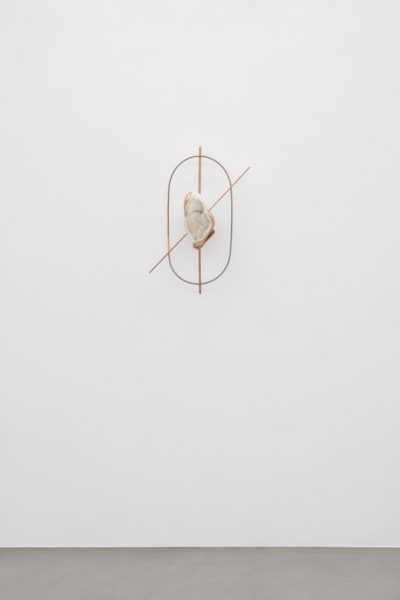 Ivana Bašić, I sense that all of this is ancient and wast. I had touched the nothing, and nothing was living and moist #2, 2022, view 1White alabaster, wax, copper, pressure, grounding rods, stainless steel
Ivana Bašić, I sense that all of this is ancient and wast. I had touched the nothing, and nothing was living and moist #2, 2022, view 1White alabaster, wax, copper, pressure, grounding rods, stainless steel
66×47×19,5 cm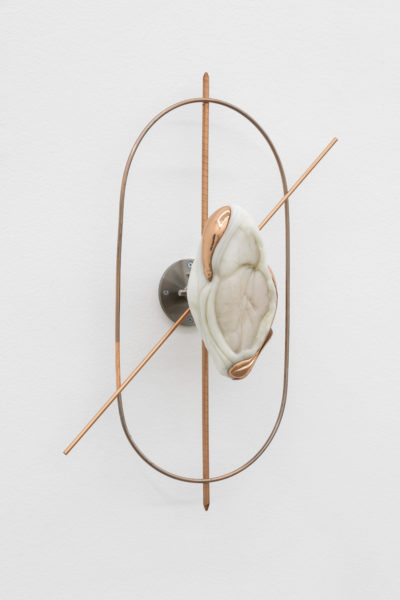 Ivana Bašić, I sense that all of this is ancient and wast. I had touched the nothing, and nothing was living and moist #2, 2022, view 2White alabaster, wax, copper, pressure, grounding rods, stainless steel
Ivana Bašić, I sense that all of this is ancient and wast. I had touched the nothing, and nothing was living and moist #2, 2022, view 2White alabaster, wax, copper, pressure, grounding rods, stainless steel
66×47×19,5 cm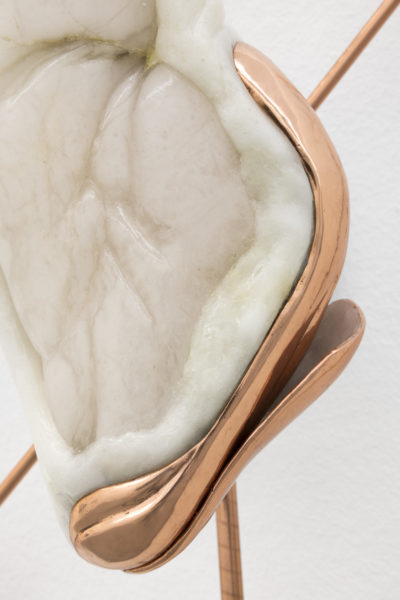 Ivana Bašić, I sense that all of this is ancient and wast. I had touched the nothing, and nothing was living and moist #2, 2022, detailWhite alabaster, wax, copper, pressure, grounding rods, stainless steel
Ivana Bašić, I sense that all of this is ancient and wast. I had touched the nothing, and nothing was living and moist #2, 2022, detailWhite alabaster, wax, copper, pressure, grounding rods, stainless steel
66×47×19,5 cm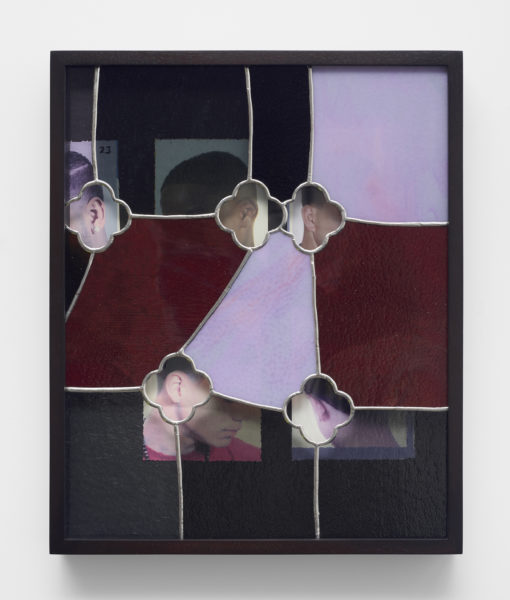 Fin Simonetti, Chapel 8, 2022stained glass, found barbershop posters
Fin Simonetti, Chapel 8, 2022stained glass, found barbershop posters
35,5×30,5 cm
Edition unique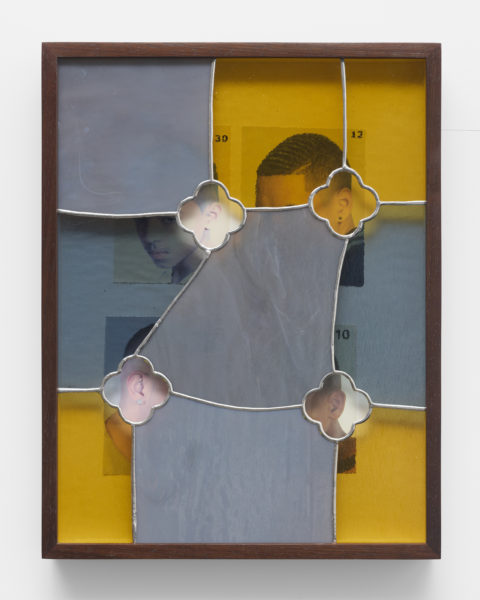 Fin Simonetti, Chapel 7, 2022stained glass, found barbershop posters
Fin Simonetti, Chapel 7, 2022stained glass, found barbershop posters
35,5×30,5 cm
Edition unique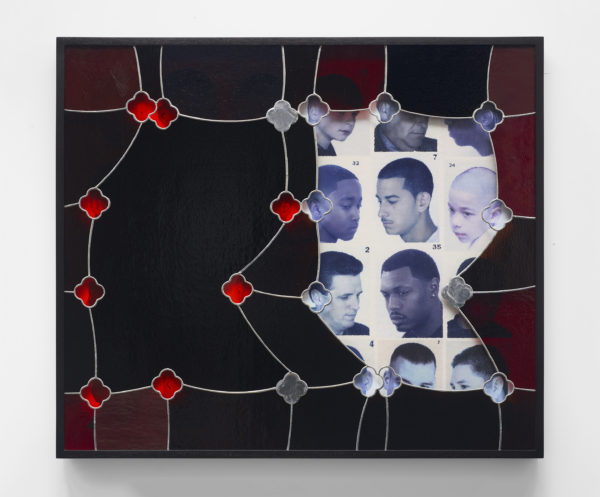 Fin Simonetti, Cathedral 14, 2022stained glass, found barbershop posters
Fin Simonetti, Cathedral 14, 2022stained glass, found barbershop posters
92×66 cm
Edition unique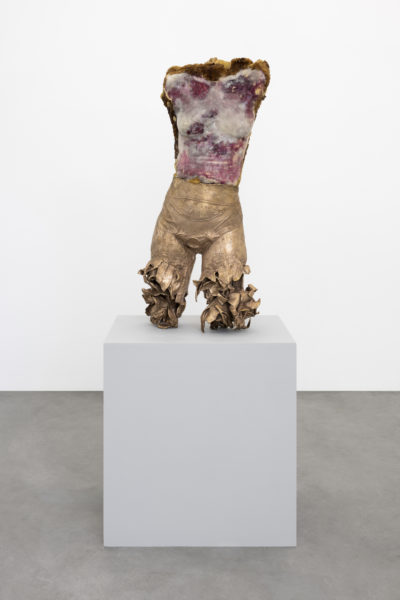 Ambra Castagnetti, Furiosa, 2022, view 1bronze, resin, wax
Ambra Castagnetti, Furiosa, 2022, view 1bronze, resin, wax
96×43×25 cm
Pedestal 80x70x50 cm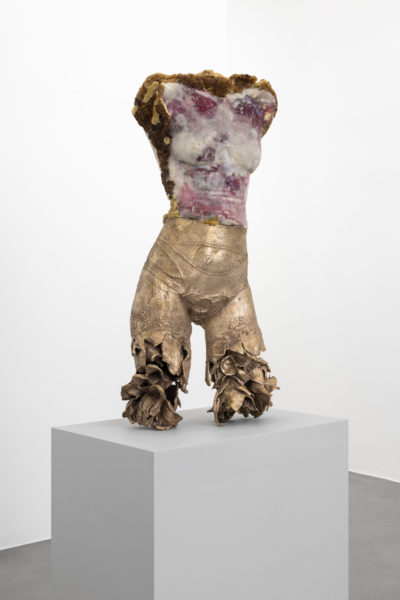 Ambra Castagnetti, Furiosa, 2022, view 2bronze, resin, wax
Ambra Castagnetti, Furiosa, 2022, view 2bronze, resin, wax
96×43×25 cm
Pedestal 80x70x50 cm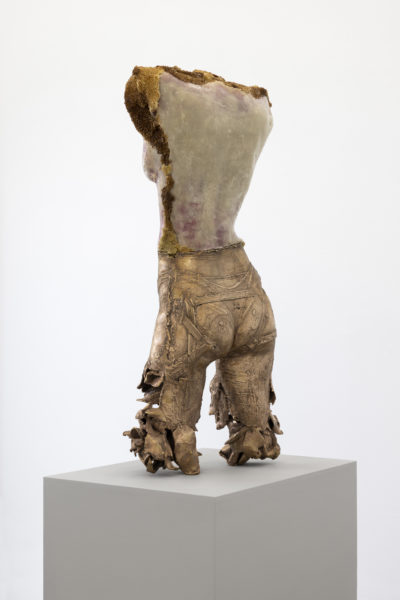 Ambra Castagnetti, Furiosa, 2022, view 3bronze, resin, wax
Ambra Castagnetti, Furiosa, 2022, view 3bronze, resin, wax
96×43×25 cm
Pedestal 80x70x50 cm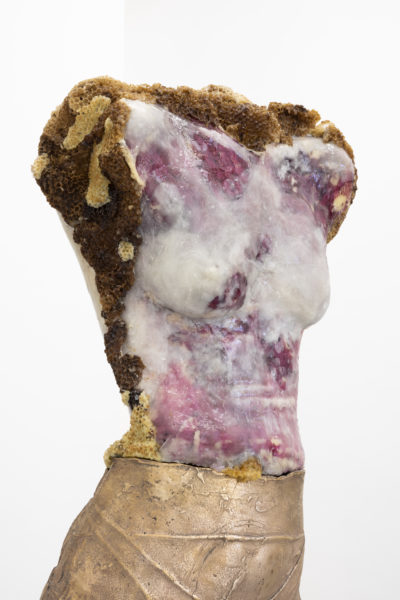 Ambra Castagnetti, Furiosa, 2022, detailbronze, resin, wax
Ambra Castagnetti, Furiosa, 2022, detailbronze, resin, wax
96×43×25 cm
Pedestal 80x70x50 cm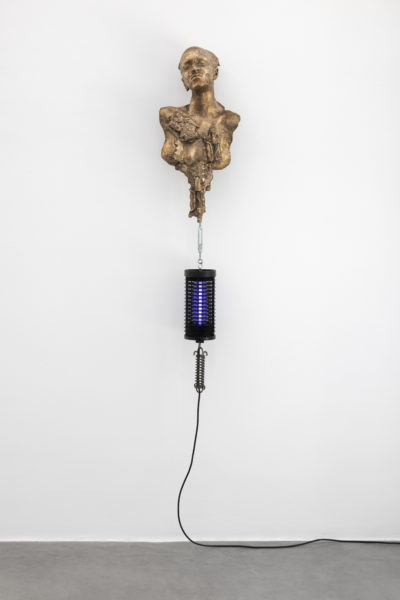 Ambra Castagnetti, You can cry on my breast, 2022, view 1bronze and mosquito lamp
Ambra Castagnetti, You can cry on my breast, 2022, view 1bronze and mosquito lamp
140×33×28 cm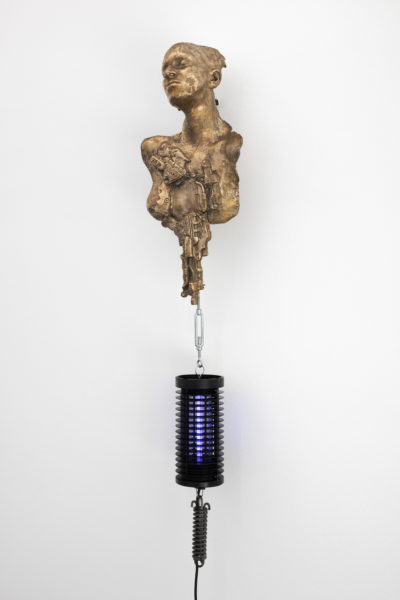 Ambra Castagnetti, You can cry on my breast, 2022, view 2bronze and mosquito lamp
Ambra Castagnetti, You can cry on my breast, 2022, view 2bronze and mosquito lamp
140×33×28 cm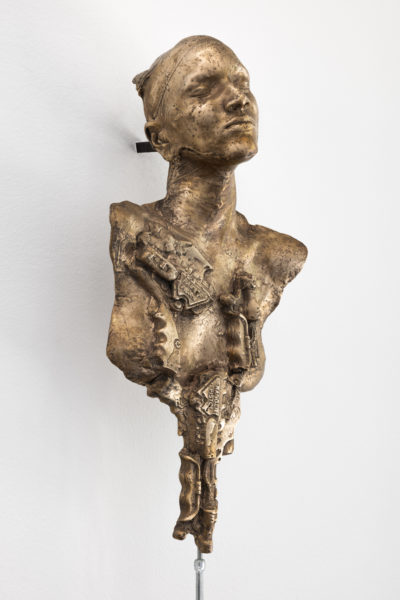 Ambra Castagnetti, You can cry on my breast, 2022, detail 1bronze and mosquito lamp
Ambra Castagnetti, You can cry on my breast, 2022, detail 1bronze and mosquito lamp
140×33×28 cm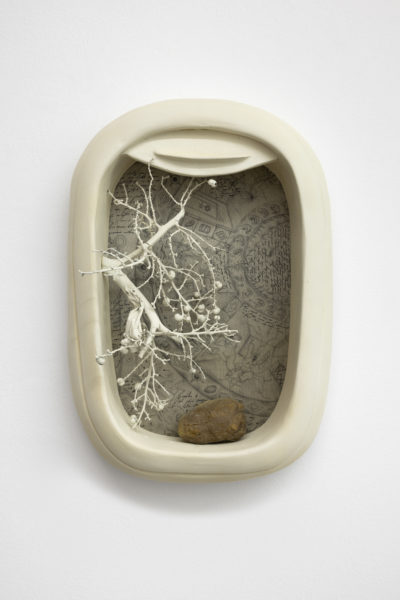 Benni Bosetto, How many bodies have you carried into your meditation?, 2022plaster, graphite on silk
Benni Bosetto, How many bodies have you carried into your meditation?, 2022plaster, graphite on silk
40×25×10 cm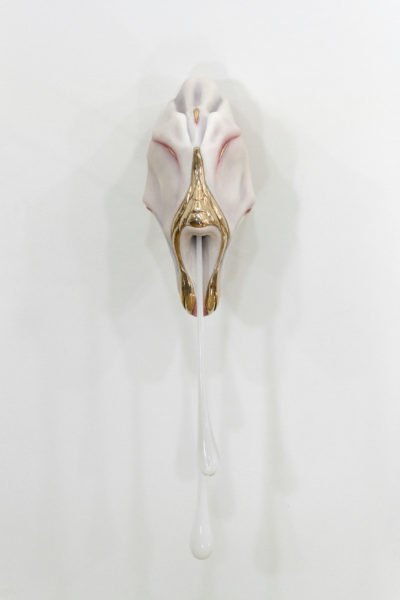 Ivana Bašić, I too had thousands of blinking cilia, while my belly, new and made for the ground was being reborn | Position III (#2), 2020, view 1wax, bronze, breath, blown glass, oil paint, stainless steel, pressure
Ivana Bašić, I too had thousands of blinking cilia, while my belly, new and made for the ground was being reborn | Position III (#2), 2020, view 1wax, bronze, breath, blown glass, oil paint, stainless steel, pressure
127×30,5×40,6 cm
Edition of 3 +AP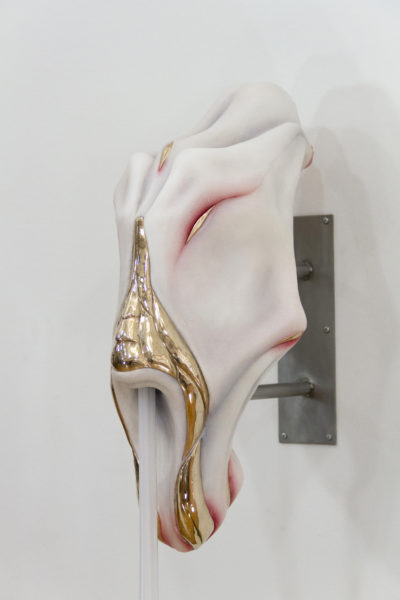 Ivana Bašić, I too had thousands of blinking cilia, while my belly, new and made for the ground was being reborn | Position III (#2), 2020, detailwax, bronze, breath, blown glass, oil paint, stainless steel, pressure
Ivana Bašić, I too had thousands of blinking cilia, while my belly, new and made for the ground was being reborn | Position III (#2), 2020, detailwax, bronze, breath, blown glass, oil paint, stainless steel, pressure
127×30,5×40,6 cm
Edition of 3 +AP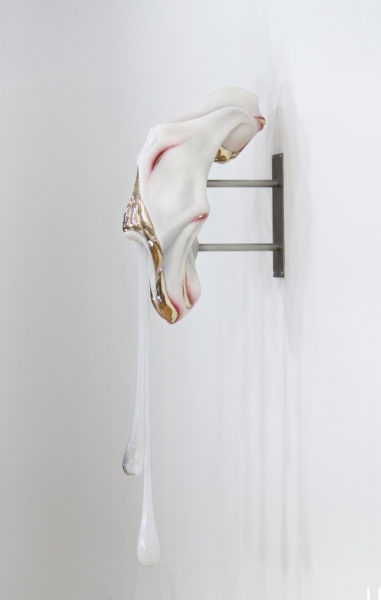 Ivana Bašić, I too had thousands of blinking cilia, while my belly, new and made for the ground was being reborn | Position III (#2), 2020, view 2wax, bronze, breath, blown glass, oil paint, stainless steel, pressure
Ivana Bašić, I too had thousands of blinking cilia, while my belly, new and made for the ground was being reborn | Position III (#2), 2020, view 2wax, bronze, breath, blown glass, oil paint, stainless steel, pressure
127×30,5×40,6 cm
Edition of 3 +AP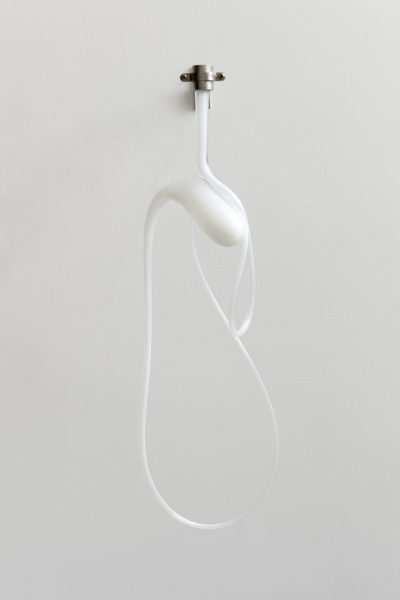 Ivana Bašić, Breath seeps through her tightly closed mouth | Position II: Swelling #1, 2019, view 2breath, glass, stainless steel, torque
Ivana Bašić, Breath seeps through her tightly closed mouth | Position II: Swelling #1, 2019, view 2breath, glass, stainless steel, torque
76,2×30,5×12,7 cm
Edition unique Ivana Bašić, Breath seeps through her tightly closed mouth | Position II: Swelling #1, 2019, view 1breath, glass, stainless steel, torque
Ivana Bašić, Breath seeps through her tightly closed mouth | Position II: Swelling #1, 2019, view 1breath, glass, stainless steel, torque
76,2×30,5×12,7 cm
Edition unique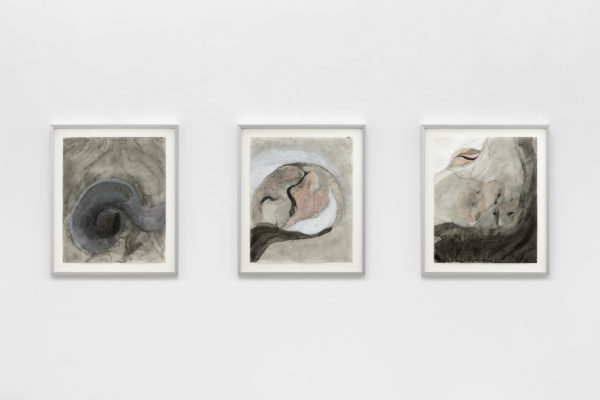 Untitled, 2022watercolor and resin
Untitled, 2022watercolor and resin
51×43,5×3,5 cm
each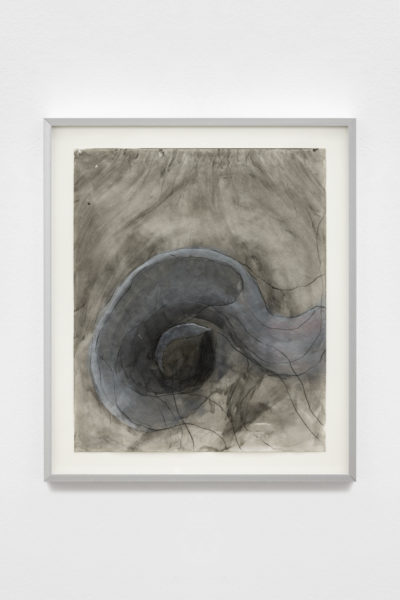 Untitled 1/3, 2022watercolor and resin
Untitled 1/3, 2022watercolor and resin
51×43,5×3,5 cm
each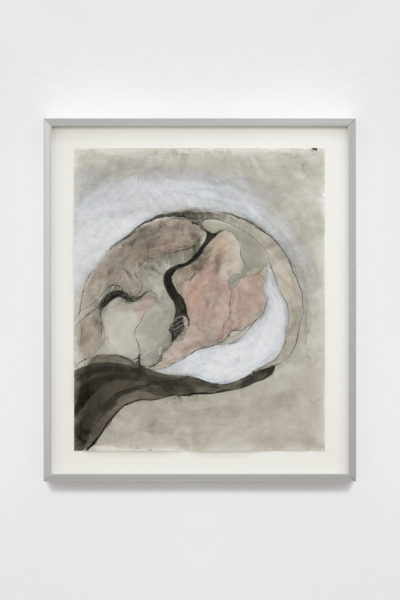 Untitled 2/3, 2022watercolor and resin
Untitled 2/3, 2022watercolor and resin
51×43,5×3,5 cm
each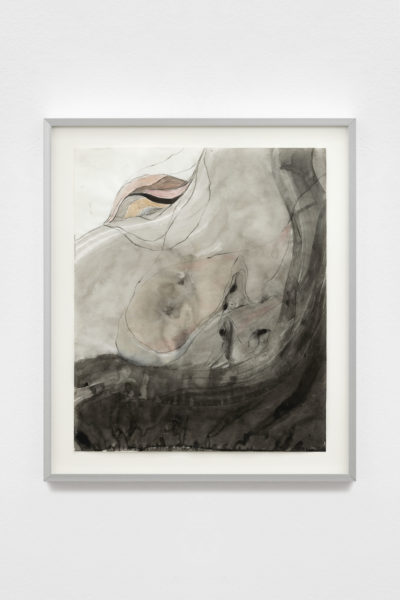 Untitled 3/3, 2022watercolor and resin
Untitled 3/3, 2022watercolor and resin
51×43,5×3,5 cm
each



























































































